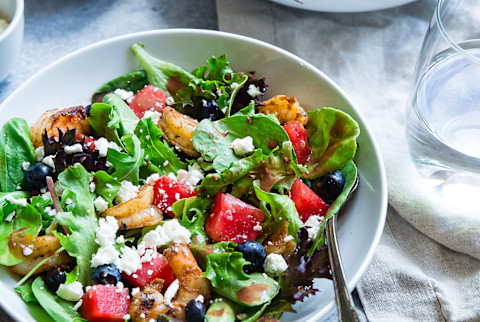3 Ways To Make Your Salad Dressing More Nutritious & Delicious

Traditional store-bought salad dressings are convenient, no doubt, but they might become boring after one or two uses. And with loads of additional salt, sugars, and artificial flavors, the actual perks of these dressings seem to be fairly low compared to a homemade recipe.
At the same time, making a salad dressing that's equally tasty and good for you isn't necessarily intuitive. See, salad dressing is somewhat of an art, one that may take practice but will become easier after each batch. First, let's cover the basics:
Get playful with spices & herbs
There is a whole world beyond salt and pepper that you can and should explore when crafting your dressing.
Want to add some spice? Reach for cayenne pepper, red pepper flakes, or finely chop some jalapeño. Craving an Italian-inspired dressing? Go beyond oil and vinegar by adding fresh basil, oregano, and garlic to the mix.
You get the point—truly utilizing herbs and spices will certainly level up your basic salad dressing. If you don't have time to finely chop your fresh herbs, toss all of your ingredients into a blender instead.
Add supplements to the mix
If you're already taking a powder supplement of some kind, you may consider tossing it in your salad dressing to check that item off your list with minimal effort.
Of course, a sweet-flavored supplement won't do, but any unflavored option like the mindbodygreen beauty & gut collagen+ could certainly level up the health benefits of your salad dressing without disturbing the taste.*
You may also consider a greens powder or protein powder for this step, though you'll want to make sure they're truly flavorless before mixing them in (and not many are). If they have a thicker consistency, you may also want to blend them into your dressing rather than rely on a bowl and spoon.
Build off a creamy base
If you're going to spend a bunch of time chopping up your veggies and grilling your protein to perfection, your dressing should measure up to the calculated textures you've created thus far. A watery dressing that trickles to the bottom of your bowl just won't do the job here.
Instead, create a creamy, structured base for your dressing. This way, it'll coat each chopped veggie and slice of protein (be it chicken, tempeh, etc.), helping your salad hold on to the flavor.
You can enlist protein-rich plain Greek yogurt, blend your dressing ingredients with a feta or cottage cheese, keep tahini on hand, make the most of your mustard, or consider adding peanut butter to the mix. The goal here is to eliminate the runny dressing consistency so your dressing actually sticks to all of the moving parts of your salad or bowl.
Plus, many of these creamy bases come loaded with extra protein, so it makes reaching your daily goal of this macronutrient just a bit easier.
The takeaway
Want to level up your salad dressing? Get creative with herbs and spices, consider adding supplements for a health-forward boost, and build your recipe off a creamy base.* Chop, chop!

